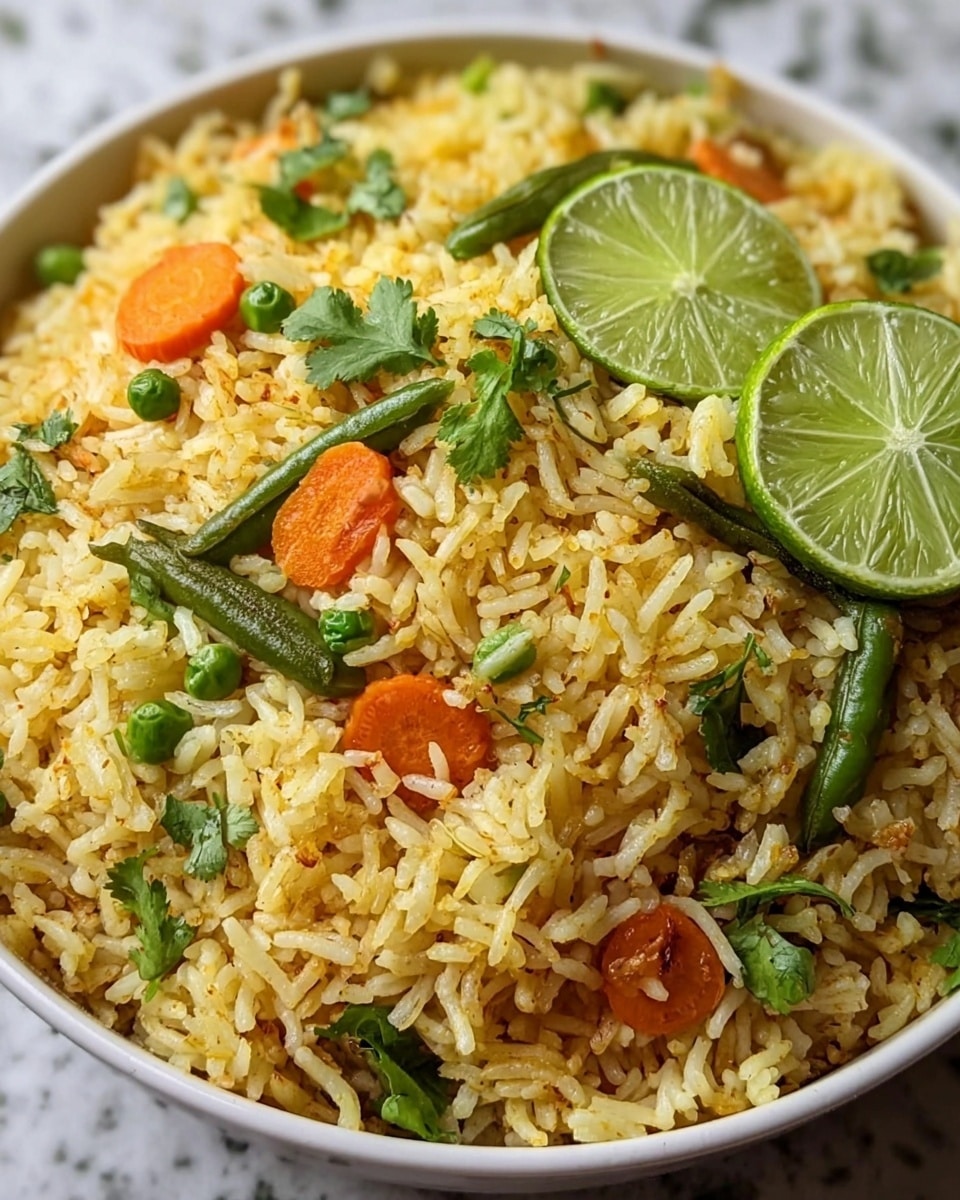If you’ve ever craved an aromatic, flavorful dish that’s bursting with vibrant colors and satisfying textures, this Vegetarian Biryani Recipe is exactly what you need. Combining fragrant basmati rice with a medley of fresh vegetables and warming spices, it delivers a comforting yet exciting meal that feels both hearty and wholesome. Every bite bursts with layers of spice and freshness, making it a beloved centerpiece for any dinner gathering or a cozy night in.
Ingredients You’ll Need
Getting the ingredients right is key to nailing the perfect Vegetarian Biryani Recipe. Each component, from the spices to the vegetables, plays a vital role in building those deep flavors and creating a beautiful balance of texture and aroma.
- Basmati rice (1 1/2 cups, rinsed and soaked): The long grains are essential for fluffy, separate rice that carries the spices beautifully.
- Water (3 cups): To cook the rice just right, ensuring it’s tender but not mushy.
- Bay leaf (1): Adds subtle earthiness to the rice while it cooks.
- Green cardamom pods (4): Infuse a sweet, floral hint that elevates the dish’s aroma.
- Cloves (4): Bring warmth and a slight pungency to the spice mix.
- Cinnamon stick (1-inch): Provides a gentle, sweet undertone that harmonizes with other spices.
- Salt (1/2 teaspoon for rice; to taste later): Enhances all flavors throughout the cooking process.
- Ghee or oil (2 tablespoons): Gives richness and helps caramelize onions and spices.
- Large onion (thinly sliced): Adds sweetness and texture when cooked golden brown.
- Garlic cloves (2, minced): Bring savory depth and a slight bite.
- Ginger (1-inch, grated): Adds fresh warmth and zestiness.
- Carrot (1, chopped): Offers mild sweetness and beautiful orange color.
- Potato (1, peeled and cubed): Gives earthy substance and satisfying softness.
- Peas (1/2 cup, fresh or frozen): Provide pops of sweetness and green freshness.
- Cauliflower florets (1/2 cup): Bring mild flavor and a lovely tender crunch once cooked.
- Green beans (1/2 cup, chopped): Add freshness and slight crispness.
- Tomato (1, chopped): Lends acidity and helps build the curry base.
- Plain yogurt (1/2 cup): Introduces creaminess and balances the spices with subtle tang.
- Biryani masala or garam masala (2 teaspoons): The signature spice blend giving the biryani its distinctive flavor.
- Ground turmeric (1 teaspoon): Adds vibrant color and mild earthiness.
- Chili powder (1/2 teaspoon): Delivers a gentle kick of heat.
- Ground coriander (1 teaspoon): Offers citrusy, nutty notes that enhance complexity.
- Fresh cilantro (1/4 cup, chopped): Provides bright herbal freshness to finish the dish.
- Fresh mint (1/4 cup, chopped): Adds a cool, refreshing contrast to the spices.
- Saffron (a pinch soaked in 2 tablespoons warm milk): Infuses luxury with its golden color and subtle floral aroma.
- Fried onions (2 tablespoons, optional): Give a crispy, caramelized crunch as a garnish.
- Roasted cashews (2 tablespoons, optional): Add buttery texture and nutty flavor.
- Raisins (1 tablespoon, optional): Introduce bursts of sweet contrast.
How to Make Vegetarian Biryani Recipe
Step 1: Cook the Rice
Start by bringing 3 cups of water to a boil in a large pot. Gently add the soaked basmati rice along with the bay leaf, green cardamom pods, cloves, cinnamon stick, and 1/2 teaspoon of salt. These whole spices will infuse the rice with a beautiful aroma as it cooks. Cook the rice until it is about 90 percent done, just tender but still firm. Drain the rice and set it aside so it’s ready to be layered later.
Step 2: Cook the Vegetables
Heat ghee or oil in a wide pan over medium heat. Add thinly sliced onions and cook until they turn a gorgeous golden brown, releasing their natural sweetness. Remove half the onions from the pan for garnishing later. Then add the minced garlic and grated ginger, sautéing for a minute until fragrant. Toss in the chopped carrots, potatoes, peas, cauliflower, and green beans. Let them cook for about 5 minutes, allowing the vegetables to soften just right.
Step 3: Build the Flavor Base
Stir in the chopped tomato, biryani masala or garam masala, turmeric, chili powder, ground coriander, and salt. Let this spice mix roast gently for 2 to 3 minutes to release its full flavor potential. Next, add the plain yogurt and continue cooking for another 2 minutes, which creates a luscious, tangy gravy that coats the vegetables perfectly.
Step 4: Layer the Biryani
In a heavy-bottomed pot, spread half of the cooked rice evenly at the bottom. Spoon the vegetable mixture generously over the rice layer. Sprinkle half of the chopped cilantro, mint, and pour half of the saffron-infused milk across the vegetables. Top this with the remaining rice, then repeat the layering with the rest of the herbs and saffron milk to create the perfect layers of flavor.
Step 5: Steam to Perfection
Cover the pot tightly with a lid to trap the steam inside. Cook the layered biryani on very low heat for 15 to 20 minutes. This gentle steaming allows the flavors to mingle beautifully and the rice to finish cooking with a fluffy, delicate texture. Once done, fluff the biryani gently with a fork.
Step 6: Garnish and Serve
Sprinkle the fried onions, roasted cashews, and raisins over the top for delightful textures and enhanced taste. Now your homemade Vegetarian Biryani Recipe is ready to be enjoyed warm, offering layers of flavor in every bite.
How to Serve Vegetarian Biryani Recipe

Garnishes
Garnishes are what elevate this dish from delicious to truly memorable. Crispy fried onions add a sweet-savory crunch, roasted cashews bring a lovely nutty touch, and raisins lend bursts of sweetness that contrast the spices. Fresh cilantro and mint sprinkled on top inject brightness and freshness that wakes up the palate. These simple finishing touches make the dish irresistibly inviting.
Side Dishes
Vegetarian Biryani pairs wonderfully with cool raita, a yogurt-based side that calms the spices with cucumber, mint, or boondi. A simple salad of sliced onions with a squeeze of lemon adds crispness. For more indulgent meals, serve alongside dal (lentil curry) or a rich vegetable korma. These combos bring balance and variety to the table, transforming your meal into a feast.
Creative Ways to Present
For a festive touch, serve the biryani layered in a decorative clay pot or a beautiful brass handi. Use fresh edible flowers, like marigold or rose petals, to garnish for a burst of color. You can also offer small bowls of garnishes like extra fried onions, cashews, and raisins on the side so guests can customize their plates. Presentation that celebrates tradition makes enjoying this Vegetarian Biryani Recipe even more special.
Make Ahead and Storage
Storing Leftovers
Vegetarian Biryani is fantastic reheated and actually tastes even better the next day once the flavors have melded. Store any leftovers in an airtight container in the refrigerator for up to 3 days. Make sure the dish cools down to room temperature before sealing to retain freshness and prevent moisture build-up.
Freezing
You can freeze your biryani if you want to prepare a big batch ahead of time. Cool it completely, then pack it in freezer-safe containers or heavy-duty zip-top bags. It will keep well for up to 2 months. When ready to enjoy, thaw overnight in the fridge for best texture and flavor preservation.
Reheating
To reheat, gently warm the biryani in a skillet on low heat or in the microwave with a sprinkle of water to restore moisture. Cover loosely while reheating to trap steam and avoid drying out the rice. Stir occasionally to re-distribute the flavors and ensure even heating. Adding a fresh garnish after reheating breathes new life into leftovers.
FAQs
Can I use other vegetables in this Vegetarian Biryani Recipe?
Absolutely! This recipe is very flexible. Feel free to add bell peppers, mushrooms, zucchini, or any other veggies you love. Just adjust the cooking times according to their textures to keep everything perfectly tender.
What can I substitute for ghee if I don’t have it?
You can easily use any neutral oil like vegetable, sunflower, or canola oil as a substitute for ghee. Olive oil works too but will give a slightly different flavor. Ghee adds a rich, buttery note, but the dish will still be delicious without it.
Is this recipe spicy? How can I adjust the heat?
The listed chili powder amount provides a mild warmth that most people find enjoyable, but it’s easy to adjust. To make it milder, reduce or omit the chili powder. For more heat, add extra chili powder or fresh green chilies during cooking.
Can I make this dish vegan?
Yes! Simply replace the yogurt with a plant-based yogurt like coconut or almond yogurt, and use oil instead of ghee. The layers of flavor will remain rich and satisfying without any dairy.
How do I prevent the rice from getting mushy?
Rinsing the basmati rice well and soaking it before cooking helps remove excess starch which is key. Also, cook the rice only until it’s about 90 percent done and let it finish cooking later during the steaming process. This approach keeps the grains separate and fluffy.
Final Thoughts
There is something wonderfully comforting and celebratory about making and sharing this Vegetarian Biryani Recipe. Its layers of fragrant spices, fresh herbs, and tender vegetables work together to create a dish that feels truly special yet is surprisingly simple to prepare. Whether for a family dinner or to impress guests, this biryani promises smiles and satisfied appetites. I hope you dive in and enjoy every flavorful bite!
Print
Vegetarian Biryani Recipe
- Prep Time: 40 minutes
- Cook Time: 35 minutes
- Total Time: 1 hour 15 minutes
- Yield: 4 servings
- Category: Main Course
- Method: Stovetop
- Cuisine: Indian
- Diet: Vegetarian
Description
This flavorful Vegetarian Biryani recipe combines aromatic basmati rice with a medley of sautéed vegetables and fragrant spices, layered and cooked to perfection. Ideal for a comforting and satisfying meal, this biryani features traditional spices like cardamom, cinnamon, and saffron complemented by fresh herbs and optional garnishes, making it a delicious and colorful dish suitable for vegetarians.
Ingredients
Rice and Spices
- 1 1/2 cups basmati rice (rinsed and soaked for 30 minutes)
- 3 cups water
- 1 bay leaf
- 4 green cardamom pods
- 4 cloves
- 1-inch cinnamon stick
- 1/2 teaspoon salt
Vegetables & Aromatics
- 2 tablespoons ghee or oil
- 1 large onion (thinly sliced)
- 2 garlic cloves (minced)
- 1-inch piece of ginger (grated)
- 1 carrot (chopped)
- 1 potato (peeled and cubed)
- 1/2 cup peas (fresh or frozen)
- 1/2 cup cauliflower florets
- 1/2 cup green beans (chopped)
- 1 tomato (chopped)
Spices & Herbs
- 1/2 cup plain yogurt
- 2 teaspoons biryani masala or garam masala
- 1 teaspoon ground turmeric
- 1/2 teaspoon chili powder
- 1 teaspoon ground coriander
- Salt (to taste)
- 1/4 cup fresh cilantro (chopped)
- 1/4 cup fresh mint (chopped)
- A pinch of saffron (soaked in 2 tablespoons warm milk)
Optional Garnishes
- 2 tablespoons fried onions
- 2 tablespoons roasted cashews
- 1 tablespoon raisins
Instructions
- Cook the Rice: In a large pot, bring 3 cups of water to a boil. Add the soaked basmati rice along with the bay leaf, green cardamom pods, cloves, cinnamon stick, and 1/2 teaspoon salt. Cook the rice until it is about 90% done, then drain the water and set the rice aside.
- Cook the Vegetables: Heat 2 tablespoons of ghee or oil in a pan over medium heat. Add the thinly sliced onions and cook them until golden brown. Remove half of the cooked onions and set aside for garnish. To the remaining onions in the pan, add minced garlic and grated ginger and sauté briefly. Then add chopped carrot, peeled and cubed potato, peas, cauliflower florets, and chopped green beans. Sauté the mixture for 5 minutes, stirring occasionally.
- Add Spices and Tomato: Stir in the chopped tomato, biryani masala (or garam masala), ground turmeric, chili powder, ground coriander, and salt to taste. Cook this spiced vegetable mix for 2-3 minutes, allowing the spices to infuse into the vegetables.
- Incorporate Yogurt: Add the plain yogurt to the vegetable mixture and cook for an additional 2 minutes, stirring continuously to combine and prevent curdling.
- Layer the Biryani: In a heavy-bottomed pot, spread half of the cooked rice evenly on the bottom. Layer the prepared vegetable mixture over the rice. Sprinkle half of the chopped fresh cilantro and mint on top. Drizzle half of the saffron-infused milk evenly over the layer. Repeat the layering process with the remaining rice, vegetables, herbs, and saffron milk.
- Cook the Layered Biryani: Cover the pot with a tight-fitting lid and cook the biryani on low heat for 15-20 minutes to allow the flavors to meld and the biryani to steam through thoroughly.
- Garnish and Serve: Carefully fluff the biryani with a fork to combine the layers lightly. Garnish the dish with the reserved fried onions, roasted cashews, and raisins as desired. Serve the biryani hot for a delightful, aromatic meal.
Notes
- Soaking the basmati rice for 30 minutes helps it cook evenly and prevents it from breaking.
- You can adjust the spice levels by varying the amount of chili powder and garam masala according to your taste.
- Using ghee adds a rich flavor, but you can substitute with vegetable oil for a vegan option.
- Optional garnishes like fried onions, cashews, and raisins add texture and sweetness, but can be omitted if preferred.
- Ensure the pot used for layering biryani is heavy-bottomed to prevent burning during the slow cooking step.
- This biryani tastes great with a side of raita or a fresh salad.









